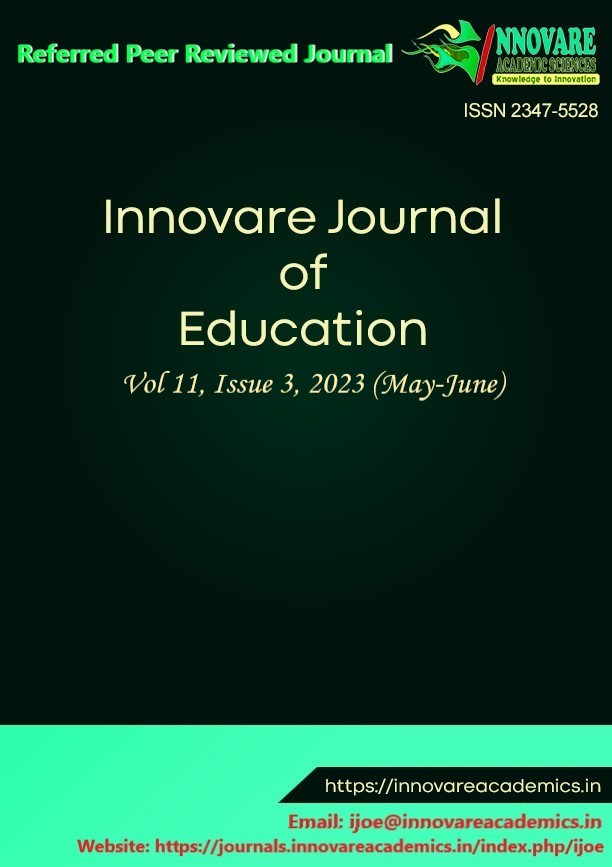Awareness and Use of Open Educational Resources and its Benefits to University Students
DOI:
https://doi.org/10.22159/ijoe.2023v11i3.47718Keywords:
open resources, educational resources, the impact of OER, type of OERAbstract
The study is descriptive survey research designed to investigate awareness and use of Open Educational Resources (OER) and its benefits to university students. The study area is Ignatius Ajuru University of Education, Port Harcourt, Rivers State, Nigeria. The study population was 424 postgraduate students in the Faculty of Education, Ignatius Ajuru University of Education. A sample of 178 students was involved in the study. A simple random sampling technique was applied in the selection process. The instrument used for the study to collect data from respondents is a structured questionnaire titled awareness and use of open educational resources and its benefits to university students (AUEORBU) with 40-item questions. The designed instrument by the researcher was given to experts in the field of educational technology. The instrument reliability determined by test-re-test was applied and the responses were correlated to obtain the reliability coefficient of .67. mean was the statistical tool used for the study. The study found that students can access open educational resources anywhere in the world, at any time and open educational resources provide an excellent way for alumni to stay connected to the institution and continue with a program of lifelong. Based on the conclusion, the researchers recommended that students and stakeholders participate fully in open educational resources to stay connected to their institutions.
Downloads
References
Bell, S. (2017). Research guides: Discovering open educational resources.
Dhanarajan, G., & Porter, D. (Eds.) (2013). Open educational resources: An Asian perspective. Commonwealth of Learning and OER Asia, Vancouver. https://www.oerknowledgecloud.org/archive/pub_PS_OER_Asia_web.pdf
Green, C. (2016). How can educators find and use open educational resources in their classrooms? Creative Commons. https://creativecommons.org/2016/09/13/find-and-use-oer/
Jeelani, S., Ramana Murthy, M. V., & Mai, A. S. (2015). The open educational resources (OERs): Challenges and opportunities in higher education. International Journal of Science, Technology and Management, 3(2), 10–16.
Karunanayaka, S. P., Naidu, S., & Menon, M. (2016). Transformational change at the intersections of technology, education and design at the open university of Sri Lanka. Commonwealth of Learning (COL) and Open University Malaysia (OUM). http://hdl.handle.net/11599/2513
Krelja, E. K. (2016). Advantages and limitations of usage of open educational resources in small countries. International Journal of Research in Education and Science, 2(1), 136–142. https://www.ijres.net/index.php/ijres/article/view/94
Manju, & Bhatt, S. (2021). Impact of open educational resources among the students and research scholars in Delhi. Library Philosophy and Practice (e-journal). 6286. https://digitalcommons.unl.edu/libphilprac/6286
Peppino, F., Liviana, M., David, B., & Piet, K. (2019). Guidebook on open educational resources (OER). https://www.researchgate.net/publication/332936553_Guidebook_on_Open_Educational_Resources_OER.
Roza, D. (2017). Challenges for implementing open educational resources by teachers in higher education. Central and Eastern European.
Sanchez, C. (2013). The use of technological resources for education: A new professional competency for teachers.
Sansom, R. L., Clinton-Lisell, V., & Fischer, L. (2021). Let students choose: Examining the impact of open educational resources on performance in general chemistry. Journal of Chemical Education, 98(3), 745–755. https://doi.org/10.1021/acs.jchemed.0c00595
The William and Flora Hewlett Foundation. (2013). Open educational resources. https://hewlett.org/wp-content/uploads/2016/08/OER%20White%20Paper%20Nov%2022%202013%20Final_0.pdf
United Nations Educational, Scientific and Cultural Organization (UNESCO). (2019). Recommendation on open educational resources. https://www.unesco.org/en/legal-affairs/recommendation-open-educational-resources-oer
United Nations Educational, Scientific and Cultural Organization (UNESCO). (2020). Recommendation on open educational resources. https://www.unesco.org/en/open-educational-resources
Wiley, D. (2016). An Open Education Reader. EdTech Books. https://edtechbooks.org/openedreader
Zhao, Y., & Satyanarayana, A., & Cooney, C. (2020, November), Impact of Open Education Resources (OER) on Student Academic Performance and Retention Rates in Undergraduate Engineering Departments Paper presented at 2020 Fall ASEE Mid-Atlantic Section Meeting, Virtual (hosted by Stevens Institute of Technology). https://peer.asee.org/36048
Published
How to Cite
Issue
Section
Copyright (c) 2023 Kasumu Rebecca Oluwayimika, Uduak Idoghor

This work is licensed under a Creative Commons Attribution 4.0 International License.





